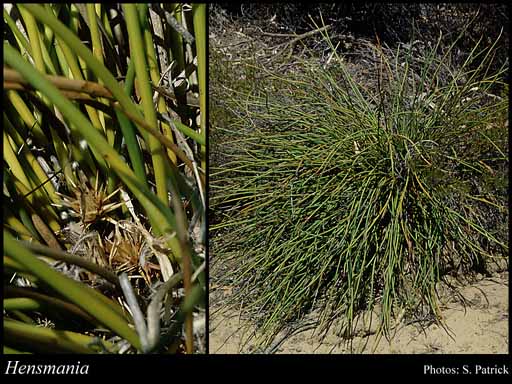- Reference
- Proc.Linn.Soc.New South Wales 28:105 (1904)
- Name Status
- Current







Scientific Description
Family Anthericaceae.
Sometimes included in Liliaceae.
Habit and leaf form. Herbs (tufted, aerial stems erect); evergreen, or deciduous. Switch-plants; with the principal photosynthesizing function transferred to stems (which look like true leaves). Leaves well developed. Perennial. Leaves basal. Plants with a basal concentration of leaves, or with neither basal nor terminal concentrations of leaves; rhizomatous. Self supporting, or climbing. Mesophytic, or xerophytic. Leaves alternate; spiral, or distichous; ‘herbaceous’, or leathery, or membranous; sessile; sheathing (sheath margin entire or scarious or split into fine hairs). Leaf sheaths not tubular; with free margins. Leaves edgewise to the stem, or with ‘normal’ orientation; simple. Leaf blades entire; flat, or folded, or solid (or triquetrous); linear, or lanceolate, or oblong, or ovate; linear; parallel-veined; without cross-venules; sheathing, outer bases scale-like. Leaves ligulate, or eligulate; without stipules. Leaf blade margins entire. Leaf anatomy. Hairs present, or absent. Extra-floral nectaries absent. Stem anatomy. Secondary thickening absent. Roots. Aerial roots present.
Reproductive type, pollination. Fertile flowers hermaphrodite. Unisexual flowers absent. Plants hermaphrodite. Floral nectaries present. Nectar secretion from the gynoecium (from septal nectaries).
Inflorescence and flower features. Flowers aggregated in ‘inflorescences’; in spikes. The terminal inflorescence unit cymose, or racemose (simple or compound). Inflorescences scapiflorous; axillary; scapes several per plant, unbranched, covered by bracts; inflorescences 2 or 3 per peduncle but usually only 1 maturing, shorter than the leaves, turbinate or ovoid; with involucral bracts (of large, chartaceous imbricate bracts, several to many, shortly pedicellate); pseudanthial, or not pseudanthial. Flowers pedicellate; bracteate (1 or more, subtend several to many flowers, scarious or membranous, sometimes as long as the flower, base entire or not entire, distal part with a dense tuft of hairs); bracteolate; small, or medium-sized; regular; 3 merous; cyclic; pentacyclic, or tetracyclic. Perigone tube present. Free hypanthium conspicuous. Perianth with distinct calyx and corolla (the whorls rather different), or of ‘tepals’; 6; 2 -whorled (3+3); isomerous; joined; petaloid; similar in the two whorls, or different in the two whorls; cream, or yellow (pale). Calyx (if the outer whorl so interpreted) 3; 1 -whorled; regular. Corolla (if the inner whorl so interpreted) 3; 1 -whorled; regular. Corolla members sometimes fringed. Androecial members definite in number. Androecium 3. Androecial members adnate (at base of perianth); all equal; free of one another; 1 -whorled, or 2 -whorled. Androecium exclusively of fertile stamens, or including staminodes. Staminodes when present, 3. Stamens 3; all more or less similar in shape; isomerous with the perianth, or diplostemonous; at the base of the inner perianth lobes; alterniperianthial, or oppositiperianthial. Anthers loosely pressed around the style; basifixed; dehiscing via longitudinal slits; introrse; tetrasporangiate. Gynoecium 3 carpelled. The pistil 3 celled. Carpels isomerous with the perianth. Gynoecium syncarpous; synstylovarious, or eu-syncarpous; superior. Ovary plurilocular; 3 locular; sessile. Gynoecium stylate. Styles 1; apical. Stigmas 1 - lobed, or 2–3 - lobed. Placentation axile. Ovules 2 per locule; arillate; campylotropous (generally), or anatropous.
Fruit and seed features. Fruit non-fleshy; dehiscent; usually a capsule. Capsules loculicidal. Fruit 3 celled; 2 seeded (per locule). Seeds endospermic; arillate. Cotyledons 1. Embryo straight to curved.
Additional characters Pollen grains trichotomosulcate.